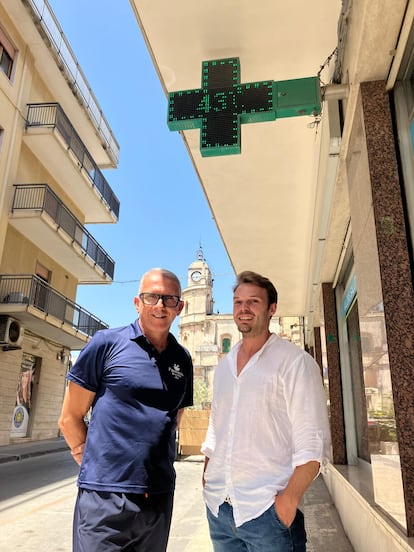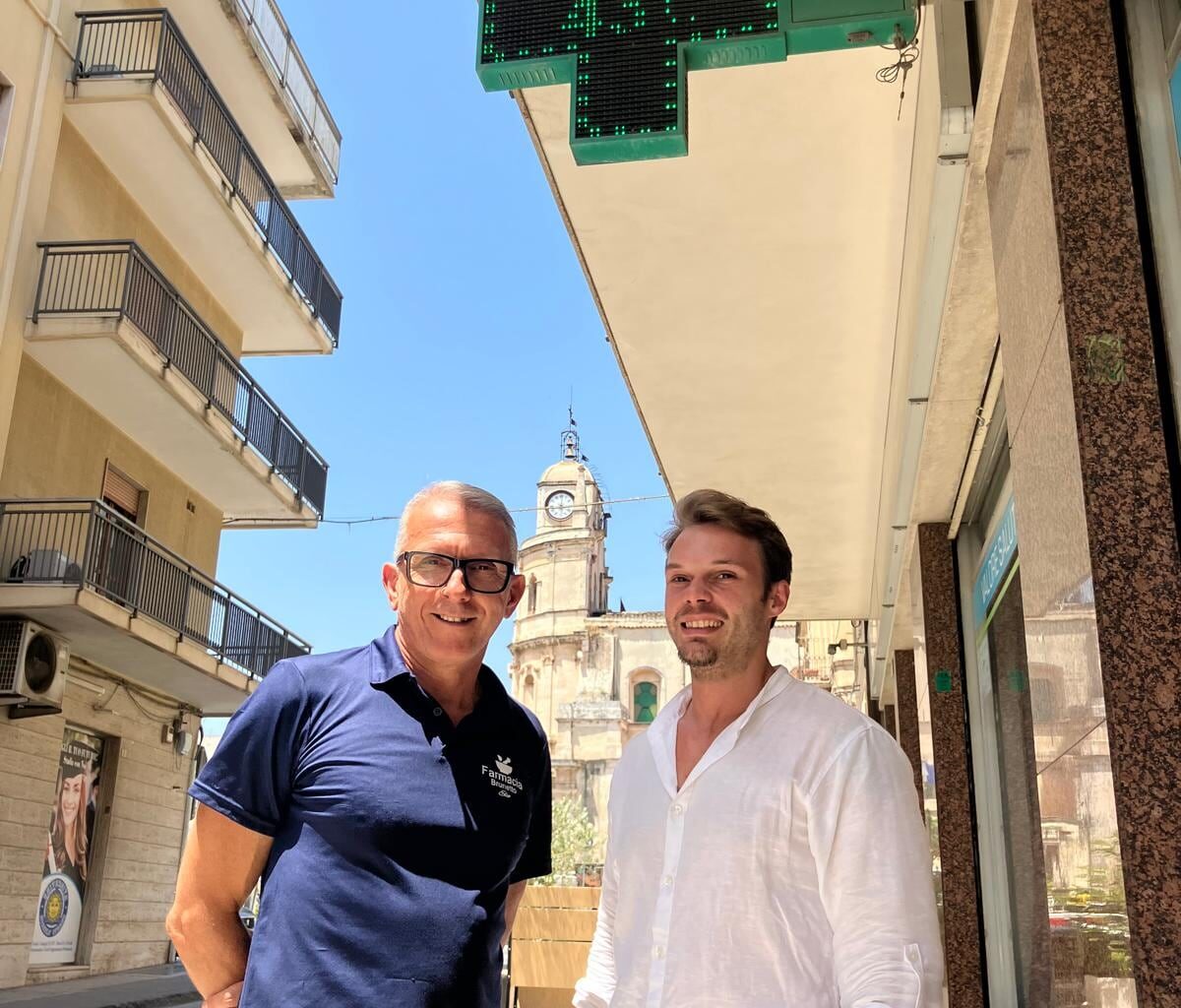 Elio Morale and Biagio Cantone in Floridia, Sicily, where the European heat record was set in 2021.Iñigo Domínguez
Elio Morale and Biagio Cantone in Floridia, Sicily, where the European heat record was set in 2021.Iñigo Domínguez
Catania is shrouded in a white mist, obscuring the horizon at sea, as if the earth were evaporating, as EL PAÍS arrives at the airport at 10 a.m. Tuesday morning. The thermometer is already reading 35 degrees Celsius (95ºF), but that’s nothing compared to what is expected, or rather feared, throughout the day: that Sicily will surpass its own heat record, the European record of 48.8ºC (119.8ºF) recorded on August 11, 2021, in Floridia, a small town 65 kilometers from Catania, in the province of Syracuse. Back then, newspaper headlines were already stating “Hell is in Sicily,” and similar things, but the Italian meteorological services have warned that perhaps new hyperbole will be necessary this week, as a heat wave threatens to break the record. For now, the metaphor being used is an “African flare,” due to the torrid winds blowing from the continent, which are responsible for rising temperatures. In more technical terms, it’s a subtropical anticyclone, and it is expected to last until Saturday.
On Monday, temperatures reached 41.8 degrees Celsius (108.8ºF), and Tuesday, a peak of up to 47ºC (111.7ºF) was expected in the same area as in 2021, the triangle between Catania, Syracuse, and Caltanisetta, the heart of eastern Sicily and one of the most beautiful places in Italy.
On Tuesday, the talk in the local villages was of nothing but the heat, and waiting to see what the maximum temperature would be. Heading toward Floridia, the site of the European record, the car’s thermometer jumps upwards as one moves away from the coast and enters the scorched yellow fields of inland Sicily, broken into deep ravines by centuries of earthquakes. They alternate with orange and lemon groves.
The cross-shaped electronic display at the Brunetto pharmacy, near the main square, reads 43ºC at noon. Upon entering, Elio Morale, who is working at the counter, smiles and calls to his colleague: “What was I telling you? The first foreign journalist is here.” It turns out that the illuminated green cross on his pharmacy is famous, because it’s the only one in town that accurately displays the temperature — as it’s in the shade — and that’s where the record was set in 2021 (although it wasn’t certified until 2024 by the World Meteorological Organization). In recent days, Morale has taken photos of the sign and posts them on Facebook. He doesn’t think the maximum temperature will be exceeded Tuesday, “but we’ll probably reach 46 degrees.” “I notice when the temperature isn’t returning to normal when my pupils burn and I can’t even ride my bike,” he explains. “Today I’ve already said I’m not going home for lunch.”
Talking to the townspeople at Bar Piperito and Bar Centrale, everyone says the same thing: “We’re used to it.” It’s assumed with a certain fatalism or lack of drama, depending on how you look at it. They say that in Sicily it’s always been very hot in the summer, that on hot nights people slept on the floor, which was cooler, or on the balcony, but what’s changed everything is air conditioning. Now you can’t live without it, even though it comes at a price: the electricity bill shoots up to around €300 or €400 euros a month ($352-$469). And in commercial premises, even more, up to €600 or €700 ($704-$821). Returning to the car at 12:40 p.m., the thermometer read 51ºC, which isn’t reliable because it was in the sun, but it makes a certain impression.
In the hardest-hit provinces of Catania, Syracuse, and Enna, authorities have opened climate shelters during the hottest hours, between 11:00 a.m. and 6:00 p.m. At that time, there are no birds; the countryside is silent. There are hardly any parks or trees in any town.
Since June, in Sicily, as in other southern regions of the country, outdoor work has been prohibited between 12:30 p.m. and 4:00 p.m. during periods of extreme heat. Driving from town to town, the fields are empty, the greenhouses deserted, and construction sites halted. From 1:00 p.m. onward, the towns empty out, everyone locks themselves in their homes, and there’s not a soul around until after 5:00 p.m. Everything is closed; they’re ghost towns.
This newspaper visits each town, looking for the verdict from the green crosses on the pharmacies. The one in Villasmundos, at 1:15 p.m., reads 44ºC. It’s on the road to Francofonte, which on Monday had one of the highest temperatures in Sicily (41.2ºC) and at 6:00 a.m. Tuesday, it was no less than 36.2ºC. “Yes, it was unusually hot. I open the bar at 3:30 a.m. because the people who are going to pick the grapes come for breakfast, and it was already hot,” says the owner of Bar Royal, one of the few that are open. He goes to the fields at night and returns around 10:30 a.m. because it’s impossible to work in the sun beyond then. At the bar is one of the villagers who has gone to harvest. He shows his cell phone with the image of the greenhouse thermometer at 9:40 a.m.: 43ºC. “And outside it was 40. Now you can’t go near it, it’s an oven,” he says.
Last stop in Catenanuova, another of the hottest villages in Europe, which registered 48.5ºC in August 1999. On Monday, as the sun set, the temperature was still 38ºC. At 4:00 p.m., the owner of the “Baggiano Bros (eat and live)” bar was alone, bored. He also runs the tobacco shop across the street and is waiting for a repairman to fix a problem. In this town, there’s an additional problem: water. It’s a chronic issue in some areas of Sicily, due to the drought, but above all to a disastrous distribution network, where more than half of the water (56%) is lost along the way, and to equally disastrous political management over the course of decades, with reservoirs unfinished. Of 47 dams, 26 are out of service or operating with limitations; in many, water is released, wasted, into the sea to avoid safety issues.
The mayor of Catenanuova, as he explained to the media, considers it almost an achievement to have water every two days, because elsewhere it’s worse, and the aqueduct from the foot of Mount Etna reaches here. The supply is rationed: there’s water only at night, for a few hours, until dawn. Residents take one shower in the morning and another at night. The rest of the day, they drink bottled water. The town’s two fountains are dry.
In Italy, the weather is increasingly being talked about, as in Spain and throughout Europe, and this week the contrast between the climatic madness is evident: while Sicily is a furnace, the north of the country is plagued by storms and floods. It’s true that the distance from Turin to Reggio Calabria is more than 1,300 kilometers (807 miles) and Sicily is right on the edge of Africa, but when the weather is on television, it records one extreme to the other in the same forecast, in the same country. Late Tuesday afternoon, the Sicilian Agrometeorological Information Service (SIAS) confirmed that this time there was no new record: in the end, Tuesday’s maximum temperature was reached in Paternò, half an hour from Catania: 45.7ºC. Francofonte came in second, with 44.5ºC. In Floridia, a phone call to the pharmacy late in the afternoon confirmed that they had reached 45ºC. However, there’s still a lot of summer remaining and August hasn’t even arrived yet.
Sign up for our weekly newsletter to get more English-language news coverage from EL PAÍS USA Edition

